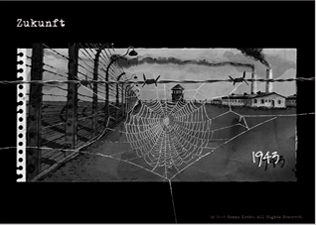Fine-Art „Giclée“-Print on canvas – stretched over a wooden frame with a depth of 2 cm
Illustration by Roman Kroke (2009)
Mesures: 40 cm x 30 cm
Customized title: language freely selectable – please specify the language of your choice during the order (in the preview: French)
Annotations to the illustration by Roman Kroke:
I created the illustration on the basis of the following citations from Etty’s diary:
“(…) we still have so much to experience together and so much work to do. And so I call upon you: stay at your inner post, and please do not feel sorry or sad for me, there is no reason to.”
3 July 1943
The illustration stands for 30 November 1943, the day on which, according to a Red Cross report, Etty was murdered in the concentration camp at Auschwitz-Birkenau. In writing her diary, Etty compared herself to a spider spinning its web (cf. annotation to the illustration “The Spider and its Web”). On the one hand, the illustration shows a spider‘s web – albeit without the spider, which symbolises Etty’s death. On the other hand, the spider’s web is complete. With this, I want to express that Etty‘s work, her diary (= the spider‘s web), had been completed on time before her death, so that the record of her perceptions might serve future generations as her spiritual legacy. You might also spot a particular connection between the spider’s web and the barbed wire fence. The barbed wire fence, a means of keeping the prisoners from escaping, did indeed dominate on the material level – Etty was murdered in Auschwitz. However, the spider’s web, a metaphor for Etty’s diary and insights, survived and prevailed on the spiritual level. The barbed wire fence even served the spider as a frame for its web. With this, I intend to highlight one of the basic principles of Etty’s philosophy: not trying to avoid the atrocities of her time but seeking a direct encounter in order to be able to dissect them intellectually. I also indicated this attitude in the illustration “Fear” by drawing the spider sitting directly on the officer’s shoulder. To summarize, the last illustration “Future” therefore stands for a certain dominance of the spiritual over the material.
Both the barbed wire fence and the threads of the spider’s web go beyond the borders of the page, thus displaying a certain independence from the rest of the illustration. The background could therefore be replaced by a different setting. This way, I want to emphasize a central concern of Etty’s. She realized that, for her own generation, the insights documented in her diary would come too late. For this reason, Etty dwelled not only upon Shoah-specific topics but also upon universal issues. She hoped that, by so doing, her thoughts could be of value for future generations, independent of the national, cultural, political or religious context.
